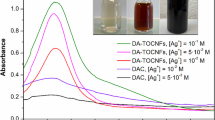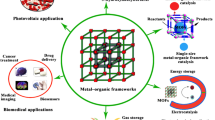Abstract
A heteropore covalent organic framework (COF)-based composite membrane material was prepared and proved to have a satisfactory effect on the pretreatment of vegetable samples. The composite membrane was fabricated by in situ growth of a dual-pore COF on the surface of polydopamine (PDA)-aminated non-woven (NW) fabric. Due to the difference in the strength of the interaction between the phytochromes/COF and the pesticides/COF, the removal of phytochromes and the recovery of pesticides can be achieved by adjusting the composition of the solution. Through a simple immersion or filtration operation, NW@PDA@COF composite membrane can quickly and almost completely remove interfering phytochromes in the samples. The recovery of pesticides was determined by HPLC-MS/MS, and the recovery efficiencies were 72.3~101.7% and 67.3~106.7% for immersion and filtration modes of five different vegetable samples, respectively; the RSD is between 1.1 and 19% (n = 3). The limits of detection and quantification for the 13 pesticides investigated were 0.08 μg·L−1 and 0.23 μg·L−1, respectively. A wide linear range of 1~1000 μg·L−1 was observed with R2 values from 0.9774 to 0.9998. The membrane can be repeatedly used for at least 10 times by using a facile elution treatment. Compared to other commonly used sample pretreatment materials, heteropore COF-based composite membrane is superior in terms of sorbent amount, treatment time, operation simplicity, and material reusability.
Graphical abstract








Similar content being viewed by others
References
Gu BJ, Zhang XL, Bai XM, Fu BJ, Chen DL (2019) Four steps to food security for swelling cities. Nature 566(7742):31–33
Zhang Y, Yuan XY, Jiang W, Liu HL (2020) Determination of nereistoxin-related insecticide via quantum-dots-doped covalent organic frameworks in a molecularly imprinted network. Microchim Acta 187(8):464. https://doi.org/10.1007/s00604-020-04435-z
Sun JF, Zhang XY, Li T, Xie JJ, Shao B, Xue DS, Tang X, Li H, Liu YH (2019) Ultrasensitive on-site detection of biological active ricin in complex food matrices based on immunomagnetic enrichment and fluorescence switch-on nanoprobe. Anal Chem 91(10):6454–6461. https://doi.org/10.1021/acs.analchem.8b04458
Yu J, Kim YH, Kim HM, Oh JM, Kim YR, Choi SJ (2020) Determination of the fate and biological responses of food additive silica particles in commercial foods. Food Chem 331:127304. https://doi.org/10.1016/j.foodchem.2020.127304
Guo WJ, Wang WL, Yang YX, Zhang SS, Yang BC, Ma WD, He Y, Lin ZA, Cai ZW (2021) Facile fabrication of magnetic covalent organic frameworks and their application in selective enrichment of polychlorinated naphthalenes from fine particulate matter. Microchim Acta 188(3):91. https://doi.org/10.1007/s00604-021-04750-z
Jiang HL, Xue F, Sun J, Lin JM, Zhang C, Wang X, Zhao RS (2021) Ionic covalent organic frameworks for the magnetic solid-phase extraction of perfluorinated compounds in environmental water samples. Microchim Acta 188(2):47. https://doi.org/10.1007/s00604-021-04703-6
Arabi M, Ostovan A, Bagheri AR, Guo X, Li J, Ma J, Chen L (2020) Hydrophilic molecularly imprinted nanospheres for the extraction of rhodamine B followed by HPLC analysis: a green approach and hazardous waste elimination. Talanta 215:120933. https://doi.org/10.1016/j.talanta.2020.120933
Su QZ, Vera P, Nerin C (2020) Direct immersion-solid-phase microextraction coupled to gas chromatography-mass spectrometry and response surface methodology for nontarget screening of (semi-) volatile migrants from food contact materials. Anal Chem 92(7):5577–5584. https://doi.org/10.1021/acs.analchem.0c00532
Andreas L, Anna V, Tony R, Andrew P, Regis D, Alexandra F, Christelle H, Ulrich H, Alvar DG, Burkhard L, Andreas OF (2020) Comprehensive and high-throughput exploration of chemical space using broadband 19 F NMR-based screening. Angew Chem Int Ed 59:14809–14817. https://doi.org/10.1002/anie.202002463
Ostovan A, Ghaedi M, Arabi M, Yang Q, Li J, Chen L (2018) Hydrophilic multitemplate molecularly imprinted biopolymers based on a green synthesis strategy for determination of B-family vitamins. ACS Appl Mater Interfaces 10(4):4140–4150. https://doi.org/10.1021/acsami.7b17500
Arabi M, Ostovan A, Bagheri AR, Guo X, Wang L, Li J, Wang X, Li B, Chen L (2020) Strategies of molecular imprinting-based solid-phase extraction prior to chromatographic analysis. TrAC Trends Anal Chem 128:115923. https://doi.org/10.1016/j.trac.2020.115923
Croote D, Braslavsky I, Quake SR (2019) Addressing complex matrix interference improves multiplex food allergen detection by targeted LC-MS/MS. Anal Chem (Washington, DC, U S) 91(15):9760–9769. https://doi.org/10.1021/acs.analchem.9b01388
Alvaro SM, Barbara SR, Antonio VHH, Rodriguez Delgado MA (2019) Current trends in QuEChERS method. A versatile procedure for food, environmental and biological analysis. TrAC Trends Anal Chem 116:214–235. https://doi.org/10.1016/j.trac.2019.04.018
Hou YJ, Deng JW, He KL, Chen C, Yang YY (2020) Covalent organic frameworks-based solid-phase microextraction probe for rapid and ultrasensitive analysis of trace per- and polyfluoroalkyl substances using mass spectrometry. Anal Chem 92(15):10213–10217. https://doi.org/10.1021/acs.analchem.0c01829
Ma YF, Yuan F, Yu Y, Zhou YL, Zhang XX (2020) Synthesis of a pH-responsive functional covalent organic framework via facile and rapid one-step postsynthetic modification and its application in highly efficient N1-methyladenosine extraction. Anal Chem 92(1):1424–1430. https://doi.org/10.1021/acs.analchem.9b04600
Wells SS, Kennedy RT (2020) High-throughput liquid-liquid extractions with nanoliter volumes. Anal Chem 92(4):3189–3197. https://doi.org/10.1021/acs.analchem.9b04915
Gholami H, Ghaedi M, Ostovan A, Arabi M, Bagheri AR (2019) Preparation of hollow porous molecularly imprinted and aluminum(III) doped silica nanospheres for extraction of the drugs valsartan and losartan prior to their quantitation by HPLC. Microchim Acta 186(11):702. https://doi.org/10.1007/s00604-019-3794-x
Cote AP, Benin AI, Ockwig NW, O'Keeffe M, Matzger AJ, Yaghi OM (2005) Porous, crystalline, covalent organic frameworks. Science. 310:1166–1170. https://doi.org/10.1126/science.1120411
Huang N, Krishna R, Jiang DL (2015) Tailor-made pore surface engineering in covalent organic frameworks: systematic functionalization for performance screening. J Am Chem Soc 137(22):7079–7082. https://doi.org/10.1021/jacs.5b04300
Fang QR, Zhuang ZB, Gu S, Robert BK, Jie Z, Jun Hua W, Shi Lun Q, Yushan Y (2014) Designed synthesis of large-pore crystalline polyimide covalent organic frameworks. Nat Commun 41(22):200402. https://doi.org/10.1038/ncomms5503
Feriante CH, Jhulki S, Evans AM, Dasari RR, Slicker K, Dichtel WR, Marder SR (2020) Rapid synthesis of high surface area imine-linked 2D covalent organic frameworks by avoiding pore collapse during isolation. Adv Mater 32(2):1905776. https://doi.org/10.1002/adma.201905776
Yang Y, Li GL, Wu D, Wen AY, Wu YN, Zhou XX (2020) β-Cyclodextrin-/AuNPs-functionalized covalent organic framework-based magnetic sorbent for solid phase extraction and determination of sulfonamides. Microchimica Acta 187(5):278. https://doi.org/10.1007/s00604-020-04257-z
Chen ZP, Yu C, Xi JB, Tang S, Bao T, Zhang J (2019) A hybrid material prepared by controlled growth of a covalent organic framework on amino-modified MIL-68 for pipette tip solid-phase extraction of sulfonamides prior to their determination by HPLC. Microchim Acta 186(6):393. https://doi.org/10.1007/s00604-019-3513-7
Pang ZF, Xu SQ, Zhou TY, Rong Ran L, Tian Guang Z, Xin Z (2016) Construction of covalent organic frameworks bearing three different kinds of pores through the heterostructural mixed linker strategy. J Am Chem Soc 138(14):4710–4713. https://doi.org/10.1021/jacs.6b01244
Liang RR, Xu SQ, Zhang L, Ru Han A, Pohua C, Fu Zhi C, Qiao Yan Q, Jun Liang S, Xin Z (2019) Rational design of crystalline two-dimensional frameworks with highly complicated topological structures. Nat Commun 10(1):4609. https://doi.org/10.1038/s41467-019-12596-6
Sun Q, Fu CW, Aguila B, Perman J, Wang S, Huang HY, Xiao FS, Ma S (2018) Pore environment control and enhanced performance of enzymes infiltrated in covalent organic frameworks. J Am Chem Soc 140(3):984–992. https://doi.org/10.1021/jacs.7b10642
Yuan Tao Z, Shu Rui C, Cun Xian X, Guo Yin L, Xian Liang L, Lei Z, Guo Min W, Zhi Qiong C (2018) Controllable synthesis of magnetic nanoporous carbon with tunable porosity for the efficient cleanup of vegetable samples. Anal Chim Acta 1041:58–67. https://doi.org/10.1016/j.aca.2018.08.040
Wang ZF, Sai Nan Z, Yao C, Zhen Jie Z, Sheng Qian M (2020) Covalent organic frameworks for separation applications. Chem Soc Rev 49:708–735. https://doi.org/10.1039/c9cs00827f
Mohammed AK, Usgaonkar S, Kanheerampockil F, Karak S, Halder A, Tharkar M, Addicoat M, Ajithkumar TG, Banerjee R (2020) Connecting microscopic structures, mesoscale assemblies, and macroscopic architectures in 3D-printed hierarchical porous covalent organic framework foams. J Am Chem Soc 142(18):8252–8261. https://doi.org/10.1021/jacs.0c00555
Li W, Jiang HX, Geng Y, Wang XH, Gao RZ, Tang AN, Kong DM (2020) Facile removal of phytochromes and efficient recovery of pesticides using heteropore covalent organic framework-based magnetic nanospheres and electrospun films. ACS Appl Mater Interfaces 12(18):20922–20932. https://doi.org/10.1021/acsami.0c01608
Khan NA, Zhang RN, Wu H, Shen JL, Yuan JQ, Fan CY, Cao L, Olson MA, Jiang Z-Y (2020) Solid-vapor interface engineered covalent organic framework membranes for molecular separation. J Am Chem Soc 142(31):13450–13458. https://doi.org/10.1021/jacs.0c04589
Manchanda P, Chisca S, Upadhyaya L, Musteata VE, Carrington M, Nunes SP (2019) Diffusion-induced in situ growth of covalent organic frameworks for composite membranes. J Mater Chem A 7(45):25802–25807. https://doi.org/10.1039/c9ta11191c
Chen XS, Xia LY, Pan RP, Liu XK (2020) Covalent organic framework mesocrystals through dynamic modulator manipulated mesoscale self-assembly of imine macrocycle precursors. J Colloid Interface Sci 568:76–80. https://doi.org/10.1016/j.jcis.2020.02.046
Guo JX, Qian HL, Zhao X, Yang C, Yan XP (2019) In situ room-temperature fabrication of a covalent organic framework and its bonded fiber for solid-phase microextraction of polychlorinated biphenyls in aquatic products. J Mater Chem A 7(21):13249–13255. https://doi.org/10.1039/C9TA02974E
Qian HL, Yang CX, Yan XP (2016) Bottom-up synthesis of chiral covalent organic frameworks and their bound capillaries for chiral separation. Nat Commun 7(1):12104. https://doi.org/10.1038/ncomms12104
Xu S, Li ZX, Zhang LY, Zhang WB, Li DX (2021) In situ growth of COF-rLZU1 on the surface of silica sphere as stationary phase for high performance liquid chromatography. Talanta 221:121612. https://doi.org/10.1016/j.talanta.2020.121612
Kwon IS, Bettinger CJ (2018) Polydopamine nanostructures as biomaterials for medical applications. J Mater Chem B 6(43):6895–6903. https://doi.org/10.1039/C8TB02310G
Tang L, Yu JF, Pang Y, Zeng GM, Deng YC, Wang JJ, Ren XY, Ye SJ, Peng B, Feng HP (2018) Sustainable efficient adsorbent: alkali-acid modified magnetic biochar derived from sewage sludge for aqueous organic contaminant removal. Chem Eng J (Amsterdam, Neth) 336:160–169. https://doi.org/10.1016/j.cej.2017.11.048
Zheng W, Suttipong W, Sebastian H, Michael P, Katia R, Bernhard R, Roland AF (2020) The synergistic effect of heterostructured dissimilar metal–organic framework thin films on adsorption properties. J Mater Chem A 8:12990–12995. https://doi.org/10.1039/c9ta10264g
Funding
Financial supports from the National Key Research and Development Program of China (No. 2018YFC1602400), the National Natural Science Foundation of China (No. 21275081), and the Fundamental Research Funds for Central University, Nankai University (No. 63201043) are gratefully acknowledged.
Author information
Authors and Affiliations
Corresponding authors
Ethics declarations
Conflict of interest
The authors declare no competing interests.
Additional information
Publisher’s note
Springer Nature remains neutral with regard to jurisdictional claims in published maps and institutional affiliations.
Supplementary information
ESM 1
(DOCX 6878 kb)
Rights and permissions
About this article
Cite this article
Wang, Xh., Li, W., Jiang, Hx. et al. Heteropore covalent organic framework-based composite membrane prepared by in situ growth on non-woven fabric for sample pretreatment of food non-targeted analysis. Microchim Acta 188, 235 (2021). https://doi.org/10.1007/s00604-021-04889-9
Received:
Accepted:
Published:
DOI: https://doi.org/10.1007/s00604-021-04889-9




